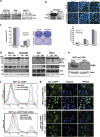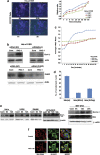ERO1α-dependent endoplasmic reticulum-mitochondrial calcium flux contributes to ER stress and mitochondrial permeabilization by procaspase-activating compound-1 (PAC-1)
- PMID: 24357799
- PMCID: PMC3877569
- DOI: 10.1038/cddis.2013.502
ERO1α-dependent endoplasmic reticulum-mitochondrial calcium flux contributes to ER stress and mitochondrial permeabilization by procaspase-activating compound-1 (PAC-1)
Abstract
Procaspase-activating compound-1 (PAC-1) is the first direct caspase-activating compound discovered; using an in vitro cell-free system of caspase activation. Subsequently, this compound was shown to induce apoptosis in a variety of cancer cells with promising in vivo antitumor activity in canine lymphoma model. Recently, we have reported its ability to kill drug-resistant, Bcl-2/Bcl-xL overexpressing and Bax/Bak-deficient cells despite the essential requirement of mitochondrial cytochrome c (cyt. c) release for caspase activation, indicating that the key molecular targets of PAC-1 in cancer cells are yet to be identified. Here, we have identified Ero1α-dependent endoplasmic reticulum (ER) calcium leakage to mitochondria through mitochondria-associated ER membranes (MAM) and ER luminal hyper-oxidation as the critical events of PAC-1-mediated cell death. PAC-1 treatment upregulated Ero1α in multiple cell lines, whereas silencing of Ero1α significantly inhibited calcium release from ER and cell death. Loss of ER calcium and hyper-oxidation of ER lumen by Ero1α collectively triggered ER stress. Upregulation of GRP78 and splicing of X-box-binding protein 1 (XBP1) mRNA in multiple cancer cells suggested ER stress as the general event triggered by PAC-1. XBP1 mRNA splicing and GRP78 upregulation confirmed ER stress even in Bax/Bak double knockout and PAC-1-resistant Apaf-1-knockout cells, indicating an induction of ER stress-mediated mitochondrial apoptosis by PAC-1. Furthermore, we identified BH3-only protein p53 upregulated modulator of apoptosis (PUMA) as the key molecular link that orchestrates overwhelmed ER stress to mitochondria-mediated apoptosis, involving mitochondrial reactive oxygen species, in a p53-independent manner. Silencing of PUMA in cancer cells effectively reduced cyt. c release and cell death by PAC-1.
Figures







Similar articles
-
Induction of endoplasmic reticulum stress by ellipticine plant alkaloids.Mol Cancer Ther. 2004 Apr;3(4):489-97. Mol Cancer Ther. 2004. PMID: 15078993
-
Low-pH-induced apoptosis: role of endoplasmic reticulum stress-induced calcium permeability and mitochondria-dependent signaling.Cell Stress Chaperones. 2015 May;20(3):431-40. doi: 10.1007/s12192-014-0568-6. Epub 2015 Apr 1. Cell Stress Chaperones. 2015. PMID: 25823563 Free PMC article.
-
Perfluorooctanoic acid induces hepatocellular endoplasmic reticulum stress and mitochondrial-mediated apoptosis in vitro via endoplasmic reticulum-mitochondria communication.Chem Biol Interact. 2022 Feb 25;354:109844. doi: 10.1016/j.cbi.2022.109844. Epub 2022 Feb 4. Chem Biol Interact. 2022. PMID: 35123991
-
Oxidative protein folding in the endoplasmic reticulum: tight links to the mitochondria-associated membrane (MAM).Biochim Biophys Acta. 2010 Aug;1798(8):1465-73. doi: 10.1016/j.bbamem.2010.04.009. Epub 2010 Apr 27. Biochim Biophys Acta. 2010. PMID: 20430008 Free PMC article. Review.
-
Endoplasmic reticulum chaperones tweak the mitochondrial calcium rheostat to control metabolism and cell death.Cell Calcium. 2018 Mar;70:64-75. doi: 10.1016/j.ceca.2017.05.015. Epub 2017 May 31. Cell Calcium. 2018. PMID: 28619231 Review.
Cited by
-
The Unfolded Protein Response: At the Intersection between Endoplasmic Reticulum Function and Mitochondrial Bioenergetics.Front Oncol. 2017 Apr 3;7:55. doi: 10.3389/fonc.2017.00055. eCollection 2017. Front Oncol. 2017. PMID: 28421160 Free PMC article. Review.
-
Homocysteine facilitates endoplasmic reticulum stress and apoptosis of hepatocytes by suppressing ERO1α expression via cooperation between DNMT1 and G9a.Cell Biol Int. 2022 Aug;46(8):1236-1248. doi: 10.1002/cbin.11805. Epub 2022 Apr 14. Cell Biol Int. 2022. PMID: 35347798 Free PMC article.
-
N-Acetylcysteine Prevents the Spatial Memory Deficits and the Redox-Dependent RyR2 Decrease Displayed by an Alzheimer's Disease Rat Model.Front Aging Neurosci. 2018 Dec 6;10:399. doi: 10.3389/fnagi.2018.00399. eCollection 2018. Front Aging Neurosci. 2018. PMID: 30574085 Free PMC article.
-
Resveratrol induces autophagy-dependent apoptosis in HL-60 cells.BMC Cancer. 2018 May 22;18(1):581. doi: 10.1186/s12885-018-4504-5. BMC Cancer. 2018. PMID: 29788929 Free PMC article.
-
Mitochondria-Associated Endoplasmic Reticulum Membranes in Breast Cancer.Front Cell Dev Biol. 2021 Jan 28;9:629669. doi: 10.3389/fcell.2021.629669. eCollection 2021. Front Cell Dev Biol. 2021. PMID: 33634130 Free PMC article. Review.
References
-
- Earnshaw WC, Martins LM, Kaufmann SH. Mammalian caspases: structure, activation, substrates, and functions during apoptosis. Ann Rev Biochem. 1999;68:383–424. - PubMed
-
- Yip KW, Reed JC. Bcl-2 family proteins and cancer. Oncogene. 2008;27:6398–6406. - PubMed
-
- Thompson CB. Apoptosis in the pathogenesis and treatment of disease. Science. 1995;267:1456–1462. - PubMed
-
- Kuwana T, Newmeyer DD. Bcl-2-family proteins and the role of mitochondria in apoptosis. Curr Opin Cell Biol. 2003;15:691–699. - PubMed
Publication types
MeSH terms
Substances
LinkOut - more resources
Full Text Sources
Other Literature Sources
Research Materials
Miscellaneous

